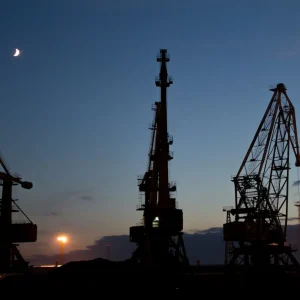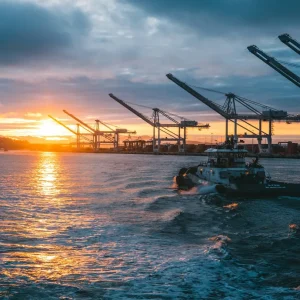
Extreme weather events are becoming more frequent and severe across the globe, with North America experiencing a significant share of these climatic disturbances. For the crane builders, hoist, and industrial lifting equipment industry, these events pose a multitude of challenges and opportunities. This article explores the impact of extreme weather on this sector, covering aspects such as operational disruptions, supply chain complications, increased demand for resilient equipment, and the role of innovation in mitigating risks.
Frequency and Severity of Extreme Weather Events
According to the National Oceanic and Atmospheric Administration (NOAA), the United States has seen a notable increase in the frequency and severity of extreme weather events over the past few decades. Hurricanes, wildfires, floods, and severe storms have become more common, posing significant threats to infrastructure and industrial operations.
Hurricanes and Storms
Hurricanes and tropical storms are among the most destructive weather events, often causing widespread damage to coastal and inland areas. These storms can lead to extensive flooding, high winds, and power outages, which can severely impact construction sites and industrial operations. The Atlantic hurricane season, which runs from June to November, has been particularly active in recent years, with notable hurricanes such as Harvey, Irma, and Maria causing billions of dollars in damage.
Wildfires
Wildfires, particularly in the western United States and Canada, have also increased in frequency and intensity. These fires can destroy vast areas of land, including industrial sites and supply chain routes. The 2020 wildfire season was one of the worst on record, with millions of acres burned and significant economic losses.
Flooding
Flooding is another major concern, often resulting from heavy rainfall or storm surges associated with hurricanes and tropical storms. Floodwaters can inundate construction sites, damage equipment, and delay projects. The 2019 floods in the Midwest United States, for instance, caused significant disruptions to infrastructure and industrial activities.
Operational Disruptions
Extreme weather events can cause significant operational disruptions for crane builders and hoist manufacturers. Construction sites are particularly vulnerable, as high winds, heavy rain, and flooding can halt work, damage equipment, and delay project timelines.
Site Closures and Delays
Construction sites often have to be shut down temporarily during extreme weather events, leading to project delays and increased costs. For example, crane operations are highly sensitive to wind conditions; high winds can make lifting operations dangerous and necessitate the cessation of work. In addition, flooding can make construction sites inaccessible, delaying the transport and assembly of cranes and hoists.
Equipment Damage
Severe weather can also damage cranes, hoists, and other lifting equipment. High winds and flying debris can damage cranes, while flooding can corrode electrical components and other sensitive parts. Repairing or replacing damaged equipment can be costly and time-consuming, further exacerbating delays and financial losses.
Supply Chain Complications
The crane and hoist industry relies on a complex supply chain that can be severely disrupted by extreme weather events. These disruptions can affect the availability of raw materials, components, and finished products, leading to production delays and increased costs.
Raw Material Shortages
Extreme weather can impact the extraction and transport of raw materials essential for crane and hoist manufacturing. For instance, hurricanes can disrupt the mining of metals, while wildfires can affect the availability of timber and other materials. These disruptions can lead to shortages and increased prices, affecting the entire supply chain.
Transport and Logistics
Transporting raw materials and finished products can also be challenging during extreme weather events. Flooded roads, damaged bridges, and disrupted rail lines can delay shipments and increase transportation costs. The 2021 Texas winter storm, for example, caused significant disruptions to transportation networks, affecting supply chains across multiple industries.
Manufacturing Delays
Manufacturing facilities themselves can be affected by extreme weather, leading to production delays. Power outages, flooding, and structural damage can halt manufacturing operations, delaying the production of cranes, hoists, and other lifting equipment. For example, the 2017 Hurricane Harvey caused significant disruptions to industrial operations in Texas, affecting numerous manufacturing facilities.
Increased Demand for Resilient Equipment
While extreme weather events pose significant challenges, they also create opportunities for the crane and hoist industry. There is an increasing demand for equipment that can withstand harsh weather conditions and ensure operational continuity.
Weather-Resistant Cranes and Hoists
Manufacturers are increasingly developing cranes and hoists designed to operate in extreme weather conditions. These include equipment with enhanced corrosion resistance, reinforced structures, and advanced control systems that can function during power outages. The demand for such resilient equipment is particularly high in regions prone to hurricanes, flooding, and other severe weather events.
Emergency Response and Recovery
Extreme weather events often necessitate rapid response and recovery efforts, creating a need for mobile cranes and lifting equipment that can be quickly deployed to affected areas. This includes cranes for clearing debris, repairing infrastructure, and supporting emergency services. The ability to provide reliable and adaptable equipment is crucial in these situations, and companies that can meet these needs are well-positioned to succeed.
The Role of Innovation
Innovation plays a crucial role in helping the crane and hoist industry mitigate the risks associated with extreme weather events. Advances in materials, technology, and design are enabling the development of more resilient and efficient equipment.
Advanced Materials
The use of advanced materials, such as high-strength alloys and composites, is helping to create cranes and hoists that can better withstand extreme weather conditions. These materials offer improved durability and resistance to corrosion, reducing the likelihood of damage and extending the lifespan of the equipment.
Smart Technologies
Smart technologies, including IoT (Internet of Things) and AI (Artificial Intelligence), are being integrated into cranes and hoists to enhance their performance and resilience. IoT sensors can monitor equipment conditions in real-time, detecting issues such as structural stress or component wear before they lead to failures. AI algorithms can optimise operations, such as adjusting lifting schedules based on weather forecasts, to minimise risks.
Modular and Mobile Designs
Modular and mobile crane designs are gaining popularity, as they offer greater flexibility and adaptability in response to extreme weather events. Modular cranes can be quickly assembled and disassembled, making them ideal for emergency response and recovery operations. Mobile cranes, mounted on trucks or other vehicles, can be rapidly deployed to affected areas, providing essential lifting capabilities when and where they are needed most.
Industry Collaboration and Best Practices
Addressing the challenges posed by extreme weather events requires collaboration across the crane and hoist industry. Companies, industry associations, and regulatory bodies are working together to develop best practices and standards that enhance resilience and safety.
Industry Associations
Industry associations, such as the Crane Manufacturers Association of America (CMAA) and the Hoist Manufacturers Institute (HMI), play a key role in promoting best practices and standards. These organisations provide guidance on safety, design, and operation, helping companies to improve the resilience of their equipment and operations.
Regulatory Compliance
Compliance with regulatory standards is essential for ensuring the safety and reliability of cranes and hoists. Regulatory bodies, such as the Occupational Safety and Health Administration (OSHA) in the United States and the Canadian Standards Association (CSA) in Canada, establish safety standards and guidelines that companies must adhere to. These standards often include provisions for operating in extreme weather conditions, helping to mitigate risks and enhance resilience.
Research and Development
Ongoing research and development (R&D) efforts are critical for advancing the resilience and performance of cranes and hoists. Companies are investing in R&D to develop new materials, technologies, and designs that can better withstand extreme weather conditions. Collaboration with academic institutions and research organisations is also common, fostering innovation and the exchange of knowledge.
Conclusion
Extreme weather events pose significant challenges to the crane builders, hoist, and industrial lifting equipment industry in North America. These events can cause operational disruptions, supply chain complications, and increased demand for resilient equipment. However, they also present opportunities for innovation and industry collaboration. By investing in advanced materials, smart technologies, and modular designs, and adhering to best practices and regulatory standards, the industry can enhance its resilience and continue to thrive in the face of an increasingly volatile climate.
The future of the crane and hoist industry will depend on its ability to adapt to these changing conditions and to provide reliable, resilient equipment that meets the evolving needs of its customers. Through innovation and collaboration, the industry can overcome the challenges posed by extreme weather events and continue to support the growth and development of North America’s industrial landscape.






